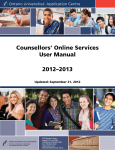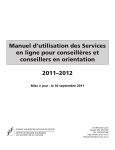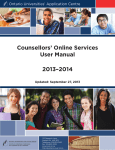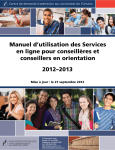Download Counsellors' Online Services User Manual 2011–2012
Transcript
Counsellors’ Online Services User Manual 2011–2012 Updated: September 30, 2011 170 Research Lane Guelph ON N1G 5E2 Phone: 519-823-1940 www.ouac.on.ca http://guidance.ouac.on.ca Contents 1.0: Introduction............................................................................................................................................................. 3 2.0: Counsellors’ Online Services Login ........................................................................................................................ 4 3.0: Navigating Counsellors’ Online Services................................................................................................................ 6 4.0: Access Levels to Counsellors’ Online Services........................................................................................................ 8 5.0: Account Information............................................................................................................................................... 9 6.0: Create a PIN........................................................................................................................................................... 10 7.0: Data Upload/Download........................................................................................................................................ 14 7.1: Data Upload..................................................................................................................................................... 14 7.2: Data Download ............................................................................................................................................... 19 8.0: Inquiry.................................................................................................................................................................... 22 9.0: Academic Updates................................................................................................................................................. 25 9.1: 9.2: 9.3: 9.4: Update Courses................................................................................................................................................ 28 Add Courses...................................................................................................................................................... 29 Drop/Re‑Add Courses....................................................................................................................................... 31 Update Other Information.............................................................................................................................. 32 10.0: Reports................................................................................................................................................................. 34 10.1: 10.2: 10.3: 10.4: 10.5: Applicant Status Report................................................................................................................................ 35 Grades Report................................................................................................................................................ 36 Choices by University Report......................................................................................................................... 37 PIN Checklist................................................................................................................................................... 38 January Admission (Winter Entry) Applicant Report.................................................................................. 39 1.0: Introduction This manual replaces the 2010-2011 Counsellors’ Online Services User Manual that was published on October 7, 2010. Counsellors’ Online Services (COLS) are a collection of web‑based services intended to provide authorized Ontario secondary school officials with user‑friendly access to the information that is on file for students in the OUAC database. Counsellors’ Online Services will be available 19 hours a day, 7:00 a.m. to 2:00 a.m., Eastern Time (ET). Useful Links Counsellors’ Online Services link: http://guidance.ouac.on.ca General undergraduate application website: www.ouac.on.ca/applications/ 101 Application website: www.ouac.on.ca/ouac-101/ The Guidance website: http://guidance.ouac.on.ca Ce document est également disponible en français : http://orientation.ouac.on.ca. You can download and print additional copies of this publication at http://guidance.ouac.on.ca. To obtain this document in an alternative format, contact: The Ontario Universities’ Application Centre (OUAC) 170 Research Lane Guelph ON N1G 5E2 Telephone:519‑823‑1940 Fax: 519‑822‑1682 Email: [email protected] Website: www.ouac.on.ca/about/about-accessibility/ Counsellors’ Online Services User Manual 2011-2012 3 2.0: Counsellors’ Online Services Login Counsellors’ Online Services can be found on the OUAC’s guidance counsellor website at: http://guidance.ouac.on.ca. Simply select “Log in” on the right‑hand side of the page, directly below the “Counsellors Online Services” heading (Fig. 1). Fig. 1 4 Counsellors’ Online Services User Manual 2011-2012 Each individual will log in to Counsellors’ Online Services using his or her personal User ID and password. These User IDs and passwords are mailed to schools starting in late September once a registration form is completed by the school and returned to the OUAC. For security and confidentiality reasons, all users must register each year, even if they were authorized users in the previous year. Figure 2 shows the main page of Counsellors’ Online Services. Fig. 2 Counsellors’ Online Services User Manual 2011-2012 5 3.0: Navigating Counsellors’ Online Services The following pages provide definitions of some of the terminology associated with the screens that you will encounter while navigating the site. Title Bar Across the top of the screen is the Counsellors’ Online Services title bar (Fig. 3). Fig. 3 Screen Title Under the title bar is the screen title (Fig. 4). The title for this screen is “Add Course(s)”. “Add Course(s)” is a function within “Student Grades” and “Student Grades” is a function within “Academic Updates”. Fig. 4 Left‑hand Menu Bar The left‑hand menu bar (Fig. 5) allows you to move quickly between the screens of Counsellors’ Online Services. Please keep in mind that when using functions that create/change data, such as “Create a PIN”, “Data Upload/Download” and “Academic Updates”, you should complete and save your work in that function before moving to another function. Fig. 5 Button Clicking on a button will cause an action to occur. Figure 6 depicts three buttons: “Drop Checked Course(s)”, “Add Course(s)” and “Return to Student List”. Fig. 6 6 Counsellors’ Online Services User Manual 2011-2012 Text Box, Drop‑down Menu and Check Box The screen below (Fig. 7) illustrates the three ways that information may be entered. 1. Drop‑down menu: Click the downward arrow to view a selection of values. Then click the appropriate value to select it. “Completion Date”, “Credit”, “Mark”, “Grade Type”, “Language of Instruction”, “Delivery” and “Course Type” have drop‑down menus. 2. Check box: The “Notes” field uses check boxes. One or more boxes can be clicked to check/uncheck the box. 3. Text box: Click the box and type the information into the box. The “Mident” field uses a text box. 1 2 3 Fig. 7 Counsellors’ Online Services User Manual 2011-2012 7 4.0: Access Levels to Counsellors’ Online Services Note the functions available on the left‑hand menu bar (Fig. 8). Since users have been granted different access levels to Counsellors’ Online Services, some will be able to use all the functions on the left‑hand menu bar while others will only be able to use some of those functions. Fig. 8 In September, you and the principal/vice-principal at your school completed SSOLA registration forms to register various individuals for access to Counsellors’ Online Services. On the registration forms, each registrant was given a specific level of access. One individual at your school was given “Administrator level” access. This individual has access to all functions provided in Counsellors’ Online Services. Other individuals at your school could be registered with one or more of these levels of access: • Inquiry • Inquiry and Academic Updates • Submit Electronic Data The chart on the right indicates the menu options available to individuals, depending on the level of access indicated on their registration form. If an individual was given more than one access level on the registration form, the functions available are cumulative. For example, if someone were given access to the “Inquiry” and the “Submit Electronic Data” options then, after logging in, the individual would be able to access the options for both levels: • Account Information • Data Upload/Download • Inquiry • Reports 8 Access Level Functions Available Inquiry • • • Account Information Inquiry Reports Inquiry and Academic Updates • • • • • Account Information Create a PIN Inquiry Academic Updates Reports Submit Electronic Data • • Account Information Data Upload/Download Counsellors’ Online Services User Manual 2011-2012 5.0: Account Information When a user selects “Account”, the system displays the User ID of the person who is logged in for the current session (Fig. 9). This screen also provides instructions for logging out of the system. Fig. 9 Counsellors’ Online Services User Manual 2011-2012 9 6.0: Create a PIN The “Create a PIN” function allows you to create an account for one or more students and store it on the OUAC’s database. Most accounts are created when your school submits a file of demographic and academic data to the OUAC in the October/November submission. The “Create a PIN” function is used when it is not possible to submit such a file to the OUAC. For example: • • • • • Your school does not have a computer system that generates academic data in the format required by the OUAC as specified in the OCAS/OUAC Secondary School Data Transmission Specification. Students are applying to winter‑entry programs. After the October/November data submission, a student transfers to your school from outside Ontario or from a non‑SSOLA school within Ontario, and the student needs to get access codes including a PIN in order to apply to university. A student who did not attend school in the fall registers at your school for the second semester. A student’s record was inadvertently missed in the October/November data submission. Accounts generated with the “Create a PIN” function will contain only minimal information about the student: his or her given name, surname, secondary school student number (SSSN) and Ontario Education Number (OEN). It will not contain any of the demographic or academic data that is normally sent in the October/November data submission. After an account has been generated using the “Create a PIN” function, the OUAC will mail, to the guidance office, an Application Access Code Letter for the student(s) and a checklist of all the PINs. Typically, your school will receive these materials within a week of completing the “Create a PIN” function, although the timing also depends on the speed of the mail delivery service. A “current” PIN checklist of your OUAC applicants will also be available using the “Reports” option of Counsellors’ Online Services. One business day after you have created a PIN, the PIN checklist will include the newly created PIN information. After students have received their Application Access Code Letter, they can log in to the online application and apply to university. Since their academic data does not exist on the OUAC database, students will not be able to view academic data at this point in the application process. After they have completed and submitted the online application and it has been processed (approximately one business day), you will be required to enter the student’s academic information using the “Academic Updates” function. Students who apply after the OUAC has received an electronic grades file will need to have their current grades data added to their file. However, if the school/board has included academic data in their electronic file for the applicant in the November transmission, the OUAC will populate the grades received once the applicant has applied. Any further updates or additions to the applicant’s academic data will need to be completed using the Counsellors’ Online Services “Academic Updates” option. Students whose accounts were created from the October/ November data submissions will be able to review the academic data in the database when they first begin their 101 application. 10 Counsellors’ Online Services User Manual 2011-2012 After selecting “Create a PIN” from the left‑hand menu bar, you will see the screen below (Fig. 10). Click “Add Account(s)” to begin creating one or more accounts. Fig. 10 Counsellors’ Online Services User Manual 2011-2012 11 By selecting “Add Account(s)”, you will be presented with a screen where up to five student records can be created at a time. Please note that each student must have a unique SSSN and OEN. The SSSN must be 12 digits long. If your school’s student numbers are shorter than 12 digits, add zeros to the beginning of the number. For example, for a nine‑digit student number of “123456789”, enter “000123456789” to make 12 digits. The OEN must be nine digits long. Note: Should you receive a “Duplicate” error message, a PIN may have been already assigned with an identical SSSN or OEN. Contact the OUAC’s Secondary School Division for assistance. The “Add Accounts” screen is depicted below (Fig. 11). Fig. 11 12 Counsellors’ Online Services User Manual 2011-2012 After entering data for one to five accounts, click “Add Account(s)” at the bottom of the screen. You will return to the previous screen where you will see the accounts listed that you have just entered. The screen below (Fig. 12) displays created accounts. Fig. 12 The list of accounts can be sorted by “SSSN”, “Last Name” or “Date Added” by clicking the appropriate column title. At this point, you may choose “Add Account(s)” again to add up to five students at a time or you can delete one or more accounts by selecting the “Delete” box beside the account and then clicking “Delete Checked Account(s)”. When you are done adding and/or deleting accounts, you may proceed to another function or log out. The accounts will be created the following business day. Counsellors’ Online Services User Manual 2011-2012 13 7.0: Data Upload/Download You will only have access to the “Data Upload/Download” function if your school’s principal/vice-principal has registered you for this function. Figure 13 shows the Data Upload/Data Download screen. Data Upload The “Data Upload” function allows you to transfer a student’s demographic and academic information from your computer to the OUAC’s database. This function encrypts the data as it travels between your computer and the OUAC’s server, thereby adding another level of security. Data Download Schools are able to retrieve the OUAC Reference Number File using the “Data Download” option of Counsellors’ Online Services (Fig. 13) and can use this file to update the school or board’s grades data. Only grades for students with active applications on the OUAC database will be transmitted, thereby greatly improving the speed and accuracy of grades processing. Fig. 13 7.1: Data Upload Your software will produce a “Transmission Data File” and a “Transmission Report File”. Important: Read the information below before uploading your data. It will help you identify which file to send to the OUAC. Upload only the “Transmission Data File”, which begins with the letter “S”. Do not upload the “Transmission Report File”, which begins with the letter “R”. The “Transmission Data File” uses the following naming convention: SXXXXXX.Un XXXXXX = six‑digit school number, also known as the MIDENT number. n n n n n = = = = = 14 1 2 3 4 5 (for (for (for (for (for October/November transmission) February transmission) April transmission) July transmission) August transmission) Counsellors’ Online Services User Manual 2011-2012 For example, file names for school with MIDENT #123456: First Transmission Second Transmission Third Transmission Fourth Transmission Fifth Transmission = = = = = S123456.U1 S123456.U2 S123456.U3 S123456.U4 S123456.U5 If you know the name of the file you want to upload, you may enter its name in the text box provided (e.g., S123456.U1). Please note: The file name must be entered correctly or the data upload function will fail. Otherwise, click “Browse” to find the file on your computer (Fig. 14). Fig. 14 Counsellors’ Online Services User Manual 2011-2012 15 If you click “Browse”, a window similar to Figure 15 will appear on your screen. Using the “Browse” function is similar to using Windows Explorer. Before browsing your computer’s contents, be sure to change the “Files of type” box to “All Files (*.*)” as shown in Figure 15. Now, browse through your computer’s contents to find the file. After clicking the file to be uploaded, you will notice that it appears in the “File name” box (Fig. 15). When you are satisfied that you have selected the correct file, click “Open” on the lower right‑hand side of the window. Fig. 15 After clicking “Open” to select a file, you will return to the “Data Upload” screen. The file name will now be inserted in the text box. For example, Figure 16 shows the file name “S918679.U1” in the text box. Fig. 16 16 Counsellors’ Online Services User Manual 2011-2012 If you do not want to use the file that is in the text box, click “Browse” again to find a different file. Otherwise, if you are satisfied that the correct file name is entered into the text box, click “Send your upload”. Important: Depending on whether you are logged in as a school guidance counsellor or as a school board staff member, you will get different results after clicking “Send your upload”. For guidance counsellors, “Send your upload” will send your file to the OUAC. For school board staff, “Send your upload” will add the file to a list of files to be sent to the OUAC, in the event that you want to send more than one file. Once you have selected all of the files to be uploaded, click “Process Files” directly below the list of selected files, to send the files to the OUAC. Important: This section is only relevant to school board staff. Guidance counsellors should proceed directly to the next page. For school board staff, after clicking “Send your upload”, the file will appear in the list of files to be processed at the bottom of the screen. Figure 17 displays one file, “S887170.U1”, which is ready to be processed. Another file can be added to the list of files to be processed, by using the “Browse” button or entering the name of the file in the text box and then clicking “Send your upload”. This process can be repeated until all the files you wish to send to the OUAC are added to the list. To begin the transfer of the file(s) to the OUAC, click “Process files”. Fig. 17 Counsellors’ Online Services User Manual 2011-2012 17 After clicking “Process files”, you will see the message below (Fig. 18). The length of time required to accomplish the transfer will depend on the size of the file(s), the speed of the internet connection between your computer and the OUAC, and how busy the OUAC server is at that time. Important: Be sure to wait for the confirmation message that appears after the “Please Wait” screen below before closing your browser, otherwise your file may not arrive at the OUAC. Fig. 18 If your data file is successfully transferred to the OUAC and passes the data validity checks, you will see a confirmation message similar to the screen below (Fig. 19). Fig. 19 18 Counsellors’ Online Services User Manual 2011-2012 If your upload failed the data validity checks, the confirmation screen will provide you with information about the type of error that occurred. Please print the error screen and show it to your technical staff so the error can be resolved. If you have inadvertently tried to upload the wrong file, the error message will say: The data file has failed the validity check. We are unable to accept the data. The following error messages were found: Bad file. Too many errors. Be sure you only submit valid school files. If you wish to discuss the error with OUAC personnel, you may send an email to [email protected] or call 519‑823‑1940. 7.2: Data Download The “Data Download” function gives you the option to download the OUAC Reference Number file in either alphabetical order or in OUAC Reference Number order. After clicking “Data Download” from the “Data Upload/Download” page (Fig. 13), you will see the screen below (Fig. 20) before your page loads. Fig. 20 Counsellors’ Online Services User Manual 2011-2012 19 After the page has loaded, school board staff will see a screen similar to the one depicted in Figure. 21. Fig. 21 Counsellors will see a screen similar to the one below (Fig. 22). Fig. 22 A record layout of the file is available by clicking “Help” on the “Data Download” page. 20 Counsellors’ Online Services User Manual 2011-2012 When you select “Click here to download the file”, you will be prompted to either open or save the file (Fig. 23). Fig. 23 If you choose to save the file, you will be prompted to indicate where you want to save the file (Fig. 24). Fig. 24 Counsellors’ Online Services User Manual 2011-2012 21 8.0: Inquiry The “Inquiry” function allows you to confirm the collection of data for university applicants from your school, including the dates in which this information was forwarded to the universities selected. You may view the applicant data whether or not the application fee has been paid by the student. After clicking “Inquiry” on the left‑hand menu bar, you will be presented with a list of your school’s applicants similar to the list depicted below (Fig. 25). Scroll down to view the entire list. Click on an OUAC Reference Number (highlighted in red) to view the details for that applicant. To search for a particular applicant: • Enter either a surname (partial or full) or OUAC Reference Number in the search box. • Click “Search”. On the right‑hand side, you will see a column indicating pay status. If an applicant has paid his or her processing fees and has no outstanding payment issues, this field will be blank. However, if an applicant has payment issues, the message will indicate “No”. Please have the student contact the OUAC Payments Department directly to rectify his or her fee issues at [email protected]. Important: An applicant will appear on the list approximately one business day after the application has been completed and submitted. Fig. 25 22 Counsellors’ Online Services User Manual 2011-2012 After clicking on an applicant’s OUAC Reference Number, you will see a screen similar to Figure 26. Fig. 26 Initially, you will be presented with the applicant’s university choices as shown in Figure 26. To view more detailed information regarding when the data was transferred to the selected universities, click the arrow in the “Display Distributions” column. From the toolbar across the top of the screen, you are also able to view the applicant’s: • Personal Information • Address Information • Previous Institutions • Grades • Comments made by the secondary school (e.g., extenuating circumstances, equivalent credits) • Log of amendments made online by the applicant (date and type) • Log of amendments made to academic data, online, by school officials Counsellors’ Online Services User Manual 2011-2012 23 Within the “Grades” section, you will see a list of the applicant’s course- and diploma-related information (Fig. 27). You may also see multiple entries of the same course code. If changes have been made to a course code at each grade collection, multiple entries of the same course code are displayed. The most recent change to the course, in the current grade collection, is listed first, followed by subsequent updates. The “Source” column refers to the collection period in descending order of collection (e.g., Apr, Feb, App). App Apr Feb Jul = = = = Application submission April collection February collection July collection Fig. 27 24 Counsellors’ Online Services User Manual 2011-2012 9.0: Academic Updates The “Academic Updates” function allows you to inquire into your applicants’ files and to update the following information electronically: • • • • • • • • All courses/grades data Secondary School Diploma Indicator OSSD Issue Date Secondary School Literacy Requirement Specialist High Skills Major (SHSM) Program Code + Completion Indicator Community Involvement For International Baccalaureate schools, the IB Diploma/IB Certificate and the non‑IB designations Comments (e.g., extenuating circumstances, equivalent credits) Electronic updates made by school officials directly to the OUAC database allow for a more efficient “correction period” following each grades collection period. The “Academic Updates” function is available to school officials daily from 7:00 a.m. to 2:00 a.m., Eastern Time. After selecting “Academic Updates” on the left‑hand menu bar, you will be presented with a list of your school’s applicants, similar to the list shown in Figure 28. Scroll down to view the entire list. Note: A flag (“Yes” or “No”), indicating the receipt of electronic grades and/or online academic updates for the current collection, will appear beside each student as shown in Figure 28. It is important that you investigate if “No” appears under the “Grades File Received” column once the OUAC has processed your grades file. Verify the student’s academic record using the “Academic Updates” function or the “Inquiry” function. Click on the OUAC Reference Number to view the details for the applicant. To search for a particular applicant: • Enter either a surname (partial or full) or OUAC Reference Number in the search box. • Click “Search”. Important: An applicant will appear on the list approximately one business day after the application has been completed and submitted. Fig. 28 Counsellors’ Online Services User Manual 2011-2012 25 After clicking the applicant’s OUAC Reference Number you will see the “Student Grades” screen, similar to the one shown below (Fig. 29). Fig. 29 26 Counsellors’ Online Services User Manual 2011-2012 The following is a list of possible codes that may be presented on the “Student Grades” screen: Grade Type P C M F Delivery D = In day school C = By correspondence S = During the summer N = As a night class O= Other Course Type R= Regular O = Co‑op: “out‑of‑school” component (when indicating “O” for Course Type, you must also indicate “C” for Notes) = = = = Notes S = M = I = F = C = A = H = P = Projected course (registered for next semester) Current course Midterm mark Final mark Special indicator noting that the student’s performance in Grade 11 or 12 course was affected by extraordinary circumstances Modified course expectations that did not lead to a credit Interdisciplinary studies Course taught in French Core, Extended, or Immersion Co‑operative education Alternative expectations that do not lead to a credit Specialist High Skills Major Course taken at an inspected private school For the following values, leave the “Notes” section unchecked: B = Credit count adjusted, combined courses exceed maximum X = Substitution of a compulsory credit The table of courses at the bottom of the “Student Grades” screen contains all of the current grades information. To save your changes for the current student: • You must click “Save” on the applicable screen before proceeding to the next student or changes for the current student will be lost. As you add, update or delete courses, codes will appear in the “#/Code” column: • The “A”, “U” and “D” colour codes represent alterations to the current student that have not yet been distributed to the universities. • The “HD” colour code represents a “Historically Dropped” course that has been distributed to the universities. The course is listed in case you wish to re‑add the course. The “OI” colour represents “Other Information” (e.g., secondary school diploma, secondary school literacy requirement, community involvement, comments, SHSM program code and completion indicator) that has been modified during your current session, and will appear to the left of the label for that data. Letter Code Colour Action A Green Added courses U Pink Updated courses D Red Dropped courses HD Light Grey Historically dropped courses OI Yellow Updated “Other Information” (for current session only) Counsellors’ Online Services User Manual 2011-2012 27 9.1: Update Courses When you click on a course code on the “Student Grades” screen (Fig. 29), you will see a screen similar to Figure 30. Fig. 30 Select a value from the drop‑down boxes to change the student’s “Credit”, “Mark”, “Grade Type”, “Language of Instruction”, “Delivery” or “Course Type”. You may enter the MIDENT Number, if known, in the space provided for a course taken at a school other than the home school or use the link provided to search for the MIDENT Number. Note: The OUAC and the universities can only accept MIDENT Numbers for schools on the OUAC school file. Many night schools with valid MIDENT Numbers may not be on our school file and therefore will not be accepted. In these cases, please use the default MIDENT Number 000002 for courses taken at another secondary school/not home school. 28 Counsellors’ Online Services User Manual 2011-2012 You may check or uncheck one or more “Notes”: “Co‑operative Education”, “Course taught in French Core, Extended, or Immersion”, “Interdisciplinary Course”, “Modified Expectations”, “Performance/Extraordinary Circumstances”, “Alternative Expectations”, “Specialist High Skills Major” or “Course taken at an inspected private school”. For “Credit count adjusted, combined courses exceed maximum”, and “Substitution of a Compulsory Credit”, leave the “Notes” section unchecked. To change the course code or completion date, you must drop the course (see section 9.3 of this manual) and add a new course (see section 9.2 of this manual). To • • • save or reset your updates: Click “Reset” to remove all changes made on this screen. Click “Return to Grades Summary” to exit without saving any changes. Click “Save” to immediately save all changes and return to the “Student Grades” screen. 9.2: Add Courses When you click “Add Course(s)” on the “Student Grades” screen (Fig. 29), you will see a screen similar to Figure 31. Fig. 31 Counsellors’ Online Services User Manual 2011-2012 29 In order to fit the image on paper, Figure 31 shows the addition of only one course; however, the screen that is displayed on your computer will allow you to add up to three courses. For each course that you wish to add, you must type the five‑ or six‑digit course code in the “Course” text box. The course code must follow the Ontario Secondary School course code format. Also, for each course, you must select a value from the drop‑down boxes for: • • • • • • • • Completion Date – Year and Month Credit Mark Grade Type Language of Instruction Delivery Course Type MIDENT Number You may enter the MIDENT Number, if known, for a course taken at a secondary school other than the home school, or click on the link provided to search for the MIDENT Number. Note: The OUAC and the universities can only accept MIDENT Numbers for schools on the OUAC school file. Many night schools with valid MIDENT Numbers may not be on our school file and therefore will not be accepted. In these cases, please use the default MIDENT Number 000002 for courses taken at another secondary school/not home school. Also, you may place a check mark beside one or more “Notes”: • • • • • • • • To • • • 30 Co‑operative Education Course taught in French Core, Extended, or Immersion Interdisciplinary Course Modified Expectations Performance/Extraordinary Circumstances Alternative Expectations Specialist High Skills Major Course taken at an inspected private school save or reset your updates: Click “Reset” to remove all changes made on this screen. Click “Return to Grades Summary” to exit without saving any changes. Click “Save” to immediately save all changes and return to the “Student Grades” screen. Counsellors’ Online Services User Manual 2011-2012 9.3: Drop/Re‑Add Courses To drop a course from “Student Grades” (Fig. 29), click on the box in the column entitled “Drop”. After all the courses to be dropped have a check mark in the “Drop” column, click “Drop Checked Course(s)” at the bottom of the screen. After clicking “Drop Checked Course(s)”, the dropped course will appear at the bottom of the list and will have “Re-Add” indicated in the “Drop” column. Figure 32 illustrates how dropped courses would appear on the bottom of the “Student Grades” screen. Here, ENG4C, MCB4U and TAB45 have been dropped as indicated by the “D” in the “#/Code” column. Fig. 32 If a course was mistakenly dropped, it can be re‑activated by clicking “Re‑Add” in the “Drop” column. In the example above (Fig. 32), if ENG4C had been mistakenly dropped, you could click “Re-Add”, and the list of courses would appear as in Figure 33. Notice that ENG4C is now updated (as indicated by the “U” in the “#/Code” column), rather than dropped (as indicated by the “D” in the “#/Code” column). Fig. 33 Counsellors’ Online Services User Manual 2011-2012 31 9.4: Update Other Information Clicking “Edit” in the middle of the “Student Grades” screen (Fig. 29) will take you to the “Update Other Info” screen (Fig. 34) shown below. Here you can modify: • • • • • • • Secondary School Diploma Indicator OSSD Issue Date Specialist High Skills Major (SHSM) Program Code + Completion Indicator Community Involvement Secondary School Literacy Requirement For International Baccalaureate schools, the IB Diploma/IB Certificate and the non‑IB designations Comments (e.g., extenuating circumstances, equivalent credits) Fig. 34 32 Counsellors’ Online Services User Manual 2011-2012 “Secondary School Diploma Indicator”, “OSSD Issue Date”, “Specialist High Skills Major Program Code + Completion Indicator”, “Secondary School Literacy Requirement”, “Community Involvement” and “International Baccalaureate” designations can be changed by clicking on an item from the drop‑down list of choices. IB designation may be changed from non‑IB to Diploma or Certificate or from IB to non‑IB. Comments can be added or changed by clicking on the text box and typing the comments. Note: Not all universities make use of the school comments sent to them by the OUAC. Where the school official believes that information provided in the “Comments” field should be taken into consideration by the universities, it is important that a school official send documentation of the circumstances directly to the university admissions offices. To • • • save or reset your updates: Click “Reset” to remove all changes made on this screen. Click “Return to Grades Summary” to exit without saving any changes. Click “Save” to immediately save all changes and return to the “Student Grades” screen. Counsellors’ Online Services User Manual 2011-2012 33 10.0: Reports Five reports are available: 1. The “Current Year Applicant Status Report” provides a summary of the status of your current university applicants from your school, including the status of the OUAC fee payment, the current grades collection and the university program for which the applicant has accepted an offer of admission. The “Previous Year Applicant Status Report” provides a list of previous year applicants from your school and the university program from which the applicant has accepted an offer of admission. 2. The “Grades Report” provides a summary of a university applicant’s grades in the OUAC database. 3. The “Choices by University Report” displays applicant names and OUAC Reference Numbers sorted by program of choice within each university. 4. A current “PIN Checklist” of all of your OUAC applicants is available in both HTML and Excel format. 5. The “Winter Entry Applicant Report” lists all applicants at your school that have applied for a January Admission (winter entry) program, available in both HTML and Excel formats. You will be presented with the screen below (Fig. 35) after clicking “Reports” in the left‑hand menu bar. Fig. 35 34 Counsellors’ Online Services User Manual 2011-2012 10.1: Applicant Status Report The “Current Year Applicant Status Report” provides a summary of the status of your current university applicants from your school, including the status of the OUAC fee payment, the current grades collection and the university program for which the applicant has accepted an offer of admission. The “Previous Year Applicant Status Report” provides a list of previous year university applicants from your school and the university program for which the applicant has accepted an offer of admission. You will be presented with a complete list of applicants, as depicted in Figure 36, after selecting the applicable Applicant Status Report on the “Reports” screen. Scroll down to view the entire list. To search for a particular applicant: • Enter either a surname (partial or full) or OUAC Reference Number in the search box. • Click “Search”. Click the OUAC Reference Number to view the details for the applicant. Important: An applicant will appear on the list approximately one business day after the application has been completed and submitted for current year applicants. Fig. 36 Counsellors’ Online Services User Manual 2011-2012 35 In addition to a complete list of applicants, there are several subsets that can be viewed by clicking on one of the selections across the top of the list for the “Current Year Applicants Status Report”: • • • • • No Pays No Grades February No Grades April No Grades July Confirmed Displays a list of applicants who have not paid the application fee. Displays a list of applicants for whom the OUAC has not received February grades.* Displays a list of applicants for whom the OUAC has not received April grades.* Displays a list of applicants for whom the OUAC has not received July grades.* Displays a list of applicants who have accepted an offer of admission from one of their university selections. Note: The “Confirmed” button applies to both the “Current Year” and “Previous Year Applicant Status Reports”. * For the “Current Year Applicant Status Report”, students who applied after a particular grades collection period will have “No” displayed under the applicable “Grades Record” columns for all collections prior to applying. However, if the school/board has included academic data in their electronic file for the applicant in the November transmission, the OUAC will update the applicant’s academic record with the grades received once the applicant has applied. Any further updates or additions to the applicant’s academic data will need to be completed using the Counsellors’ Online Services “Academic Updates” option. 10.2: Grades Report The “Grades Report” provides a summary of university applicants’ grades in the OUAC database. You will be presented with a list similar to Figure 37 after selecting “Grades Report” on the “Reports” screen. The data is segmented into groups of 49 applicants and is sorted alphabetically. For example, the report below is for applicants 1–49 of a total of 646 students. Scroll down to view the entire list of 49 students. You may view the grades data for other students by selecting other groupings at the top of the screen (e.g., 50–99, 100–149, 150–199). Fig. 37 36 Counsellors’ Online Services User Manual 2011-2012 10.3: Choices by University Report The “Choices by University Report” displays applicant names and OUAC Reference Numbers sorted by program of choice within each university. The university programs are represented by the OUAC program code. For example, “AA” would represent a three‑year Arts program at Lakehead University. You will be presented with a list similar to the screen below (Fig. 38) after selecting “Choices by University Report” on the “Reports” screen. Scroll down to view the entire list. Fig. 38 Counsellors’ Online Services User Manual 2011-2012 37 10.4: PIN Checklist The “PIN Checklist” (Fig. 39) provides a current list of your university applicants’ PIN access codes that were used when applying online and that are required to access the application to review, to change, and to respond to university offers of admission. This list is provided in alphabetical order and is available in HTML or Excel format. The list is cumulative and will be modified to reflect PINs for new students for whom you have selected “Create a PIN”. Students who have already received a PIN and have transferred to your school will not appear on this list. Like all students, their PIN can be viewed using the “Inquiry Option”. Fig. 39 38 Counsellors’ Online Services User Manual 2011-2012 10.5: January Admission (Winter Entry) Applicant Report Below is a list of all applicants at your school that have applied for a January Admission (winter entry) program (Fig. 40). As students apply for January Admission (winter entry), they will be added to this list; therefore, you should return periodically to generate an updated list. This list is provided in alphabetical order and is available in HTML or Excel format. Using this list, please enter the applicant’s historical (Grade 11 and 12), midterm and, when available, final grades and OSSD related information in “Academic Updates”. Note: Applicants who have mistakenly selected January Admission (winter entry) must log in to their online application to modify the program entry point. Fig. 40 Counsellors’ Online Services User Manual 2011-2012 39 170 Research Lane Guelph ON N1G 5E2 Phone: 519-823-1940 www.ouac.on.ca http://guidance.ouac.on.ca
















































